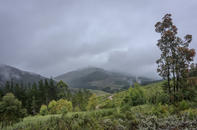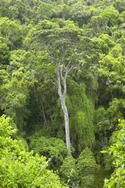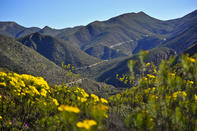Forests and Fire
Way back when the Garden Route was a terrifying section of the South African coast. The raging sea thrashed against jagged rocks. Deep, steep river gorges slashed through the cliffs to the ocean.

A dark line of mountains trapped the clouds and squeezed them for rain, which grew into tall forests that cut out the light and gave succour to a menagerie of dangerous, wild animals.
From ancient times to about 150 years ago, the entire coast from George to Plettenberg Bay was one, long impenetrable rainforest.
Over the centuries, tall indigenous giants, like the Yellowwood and the Stinkwood, grew to great heights. Moist ferns and lichens spread along the ground, and the black smell of soil was everywhere.
Today, some pockets of these indigenous forests still stand, but most have been taken out by fire, logging or pine plantations.
Logging Began

A forest full of valuable wood wouldn’t just be left to stand there and look beautiful, so logging began as soon as the settlers reached the Knysna coast.
But it took a while for technology to catch up with human avarice.
First, roads had to be built to carry the heavy timber out of the forests and sawmills had to be established before the industry could really take off.
The rugged landscape, however, made this very difficult to accomplish.
By the middle of the 1800s, however, several access routes had been hacked into the Garden Route, and lumberjacks were happily chopping down the ancient indigenous hardwoods in the most unsustainable manner imaginable.
In fact, the forests were disappearing so quickly that a conservator was appointed to control access and supervise loggers.
A few years later, unfortunately, logging restrictions were lifted because there was a growing timber shortage in the country.
The trees just couldn’t win.
The Great Fire of 1869
In 1869, a carelessly tended campfire got whipped up by the wind, and there was a forest fire in the Garden Route.
But this was no ordinary forest fire. This was the Great Fire that swept through the trees in a huge conflagration that ran from Riversdale to Humansdorp, a distance of about 350km’s. Millions of trees went up in flames, and the forests were substantially thinned out.
Only the thickest parts of the forest were saved, because of the lack of oxygen under the dense canopy.
The rest turned to ashes. The Great Fire of 1869 had a significant after-effect. It enabled road builders to entrench the hazardous timber routes and allowed them to forge new wagon paths through the attenuated underbrush. This led to years of destruction to the forest.
The World of the Klein Karoo

The Klein Karoo is a strange land, somewhat dry, somewhat fertile; a landscape of quiet delights, sandwiched between two great mountain ranges. For years, this part of the Western Cape was forlorn and forgotten by travellers, but now it is slowly gaining popularity, and with good reason.
The Klein Karoo may not boast the ceaseless fertility of the Garden Route, but it is a beautiful region with its own subtle charms.
With its russet soil and red rocks, this is the kind of place that sorts the beach bunnies from the desert dreamers.
The Klein Karoo is actually a large valley, isolated from the coast by a line of mountains to the South, and cut off from the vast interior of Southern Africa by the Swartberg to the North. At their narrowest point, the Klein Karoo plains are only a couple of km’s across.
This is a land of heat and dust and details: small farmsteads simmering under the hot sun; corrugated iron roofs, glinting next to hardy vineyards; querulous ostriches dipping their heads over the barbed wire boundary fences; and small towns, each offering their own variation of down-home country comfort with corny curio shops selling ostrich leather.
The Klein Karoo valley was first settled by white farmers in the late 18th century, as the Trekboers trickled into the region and slowly spread along its dusty leegtes "voids".
At first, the farmers either entered through Cogmans Kloof, near Montagu, or over Attaquas Kloof from Mossel Bay. Later, several other routes were pioneered over the Outeniqua mountains from Oudtshoorn to George.
By David Fleminger The Garden Route is a great way to explore the Cape Coastal region of South Africa. You can either embark on a self drive route, lingering l...
The Garden Route is a great way to explore the Cape Coastal region of South Africa. You can either embark on a self drive route, lingering l... There are South African Tourism Routes to suit you. Read this quick concise guide by independent travel writer Carrie Hampton and choose a r...
There are South African Tourism Routes to suit you. Read this quick concise guide by independent travel writer Carrie Hampton and choose a r...